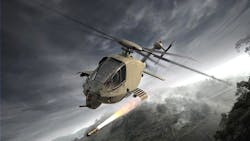Army asks industry for open-systems avionics technologies for future attack and reconnaissance helicopters
FORT EUSTIS, Va. – U.S. Army combat helicopter experts are reaching out to industry for ways to develop open-systems enabling technologies to manage aircraft crew member cognitive workload. Suggested technologies must conform to the Modular Open Systems Approach (MOSA) and Future Airborne Capability Environment (FACE) industry standards.
Officials of the Army Contracting Command at Fort Eustis, Va., issued a request for information on Thursday (W911W620RFI0002) for the Revolutionary Technology and Strategies for the Holistic Situational Awareness—Decision Making (HSA-DM) program.
The technologies developed from this program potentially are for integration into avionics for the Future Attack Reconnaissance Aircraft (FARA) and Future Long Range Assault Aircraft (FLRAA).
Other potential candidate projects for HSA-DM-developed technologies include:
-- Degraded Visual Environments-Mitigation (DVE-M);
-- Integrated Mission Equipment (IME) for Vertical Lift Systems;
-- Joint Common Architecture (JCA);
-- Route Optimization for Survivability Against Sensors (ROSAS);
-- Survivability Against Integrated and Networked Threats (SAINT);
-- Synergistic Unmanned Manned Intelligent Teaming (SUMIT);
-- Project Management Office - Command, Control, Communications, Computers, Combat Systems, Intelligence, Surveillance, and Reconnaissance (C5ISR);
-- Joint Multi-Role (JMR) Mission Systems Architecture Demonstration (MSAD); and
-- Advanced Teaming Demonstration (A-Team).
This request for information for integrated avionics aboard future Army helicopters avionics has four separate efforts: information management; data and sensor fusion; autonomous decision aiding and information distillation; and human-machine interfaces. The goal is to eventually create a family of systems that operates in a variety of domestic and combat Army helicopter missions.
Information management seeks to identify information management technologies to receive, process, store, and transmit terabytes of data and knowledge products from several sources simultaneously.
Data and sensor fusion seeks to identify technologies to accept data from several sensors, databases, and networks, and fuse the data into a comprehensive “own-ship” world model or information manager.
Autonomous decision aiding and information distillation seeks to identify technologies capable of distilling data and information into knowledge products for crew member adjudication and/or autonomous decision making.
Human machine interfaces seeks to identify technologies that facilitate intuitive communication of operational knowledge to and from aircraft crew members.
As aviation technology continues to grow, the number of separate avionics systems and large quantities of data lead to flight crew cognitive overload, Army researchers explain. The crew must search, sort, and synthesize large amounts of information across several systems. This mental load can lead to loss of situational awareness, and reduced mission effectiveness.
To address this problem, the HSA-DM program seeks to define systems that receive several data streams, and present information to the crew members in a timely and effective way. The HSA-DM program should run from 2021 to 2026.
The types of avionics systems that could be part of this program include communications; aircraft status; navigation; augmented flight control; weapons; crew systems; and fused sensor data. Proposed technologies meet standards for cyber security and information assurance.
Companies interested should email white papers no longer than 20 pages to the Army's Matthew Shivers no later than 3 June 2020 at [email protected]. Email questions or concerns to Shivers at [email protected].
More information is online at https://beta.sam.gov/opp/661e06e28c6149e9a3eaba0708fbc792/view.

John Keller | Editor-in-Chief
John Keller is the Editor-in-Chief, Military & Aerospace Electronics Magazine--provides extensive coverage and analysis of enabling electronics and optoelectronic technologies in military, space and commercial aviation applications. John has been a member of the Military & Aerospace Electronics staff since 1989 and chief editor since 1995.

